
167 Results

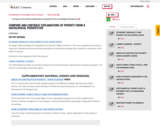
OER Text MaterialEconomic Inequality and Poverty in the United StatesSociology: Understanding and Changing the Social World: Chapter 8 Section 4. This source explains how poverty is measured. Individual and structural level explanations of poverty are provided. Also included is a discussion of the effects of poverty. Instructors could supplement with this resource:Lumen Learning - PovertyThis OER textbook provides an overview of poverty and a brief discussion of government assistance programs. The section on feminization of poverty is great.

OER Text materialExplaining StratificationSociology: Understanding and Changing the Social World Section 8.1 discusses differences in how Karl Marx and Max Weber viewed class societies. Section 8.2 provides a great discussion of theoretical perspectives on class. The section on functionalism includes an overview of Davis and Moore’s work. The conflict theory section includes a nice discussion of Marx and of false-consciousness. Instructors may want to supplement material on Weber. The section on symbolic interactionism includes a discussion of conspicuous consumption. Chapter 8 does not discuss Bourdieu, cultural capital, or social capital. Instructors interested in the social reproduction of class should consider supplemental sources.Theoretical Perspectives on Social Stratification - OpenStaxYou could supplement with Open Stax section 9.4 as it provides a summary of how each major sociological paradigm (functionalism, conflict theory, and symbolic interactionism) understands stratification. This includes a brief discussion of the Davis and Moore thesis. The conflict theory section only discusses Marx and not Weber. This section will be need to be supplemented with other sources.
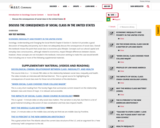
OER Text materialEconomic Inequality and Poverty in the United StatesSociology: Understanding and Changing the Social World Chapter 8 Section 4. Section 8.4 provides a good discussion of inequality and poverty, but it does not adequately discuss the consequences of social class. Overall this textbook misses the point that social class is economics plus lifestyle. Concepts such as cultural capital and everyday class consciousness,, although related to economics, impact lifestyle differences between classes; however, these concepts are not included in the textbook. Instructors wishing to make this case would benefit from including one or more of the following supplemental materials.
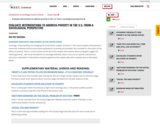
OER Text MaterialEconomic Inequality and Poverty in the United StatesSociology: Understanding and Changing the Social World: Chapter 8 Section 4. This source explains how poverty is measured. Individual and structural level explanations of poverty are provided. Also included is a discussion of the effects of poverty. There is a short section at the end of the chapter that outlines what sociologists suggest for reducing poverty. Like many introduction to sociology textbooks, there is not a lot on specific interventions. Instructors interested in interventions should supplement this chapter with other material such as that listed below.

OER Text materialSocial Class in the United StatesSociology: Understanding and Changing the Social World- Chapter 8 Section 3This section begins by explaining the difference between measuring class objectively or subjectively. A pie chart with 2008 GSS data is used to illustrate subjective measurement of social class. The section continues with a discussion of the American class structure and an overview of the major class divisions. Finally social mobility is discussed. The objectives at the start of the section state that a functionalist and conflict theorist view of the American class structure is presented, however, there is only a slight mention of these perspectives in this chapter. This is not the section to use for a theoretical discussion of class. The concepts of status, status inconsistency and status symbol are not discussed in this textbook. Conspicuous consumption is addressed briefly in section 8.2, but many key terms related to social class are missing.What is Social Stratificiation? Open Stax does provide a definition of status consistency, inconsistency and meritocracy.

OER Text materialSocial StratificationSociology: Understanding and Changing the Social World Chapter 8 Sections 1 and 3. Section 8.1 discusses different systems of stratification and the difference between closed and open systems. Section 8.3 discusses vertical mobility and inter/intra generational mobility, but not horizontal mobility. Instructors might consider supplementing this chapter with material from Open Stax and several of the supplemental material listed for this objective.Social Stratification and Mobility in the United StatesOpen Stax section 9.2- provides a fine summary social mobility and defines key terms.
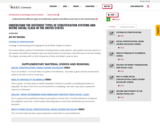
OER Text materialSystems of StratificationSociology: Understanding and Changing the Social World, Chapter 8, Section 1This section defines systems of stratification including slavery, estate systems, caste systems and class systems. It also explains the difference between open and closed systems and provides a brief discussion of vertical mobility. The chapter concludes with is a brief comparison of Marx and Weber’s views on class.


OER Text materialSocial Structure: The Building Blocks of Social LifeSociology: Understanding and Changing the Social World. Section 5.1.3 provides a basic definition of social institutions, providing examples of institutions. It also provides a working definition of society

OER Text MaterialSocial GroupsSociology: Understanding and Changing the Social World, 6.2.2. This section discusses Instrumental and expressive leadership; and authoritarian leadership, democratic, and laissez-faire leadership.
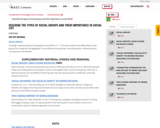
OER Text MaterialSocial GroupsSociology: Understanding and Changing the Social World, 6.1.1. This section defines and differentiates social groups from categories and aggregates. It also defines primary groups, secondary groups, reference groups, in/out-groups, and networks.

OER Text MaterialSocial Structure: The Building Blocks of Social LifeSocial Interaction in Everyday LifeSociology: Understanding and Changing the Social World, 5.1.1, 5.3.2. These sections define status roles and provide examples of ascribed status, achieved status, master status, role conflict and role strain.

OER Text MaterialGroup Dynamics and BehaviorSociology: Understanding and Changing the Social World, 6.2.3. This section reviews Asch, Milgram and Zimbardo’s experiments to discuss how groups influence conformity, and roles and authority influence obedience.

OER Text MaterialFormal OrganizationsSociology: Understanding and Changing the Social World, 6.3. This section defines the ideal type characteristics of bureaucracies, explains some disadvantages of bureaucracies and explains the iron law of oligarchy.

OER Text materialGroup Dynamics and BehaviorSociology: Understanding and Changing the Social World, 6.2.1. This section reviews dyads, triads and how group dynamics and strength alter by group size.


OER Text MaterialSocialization, Chapter 5This chapter starts with the definition of socialization as the process through which people are taught to be proficient members of a society. In addition, it describes the ways that people come to understand societal norms and expectations, to accept society’s beliefs, and to be aware of societal values. It goes further to note that socialization is not the same as socializing (interacting with others, like family, friends, and coworkers).

OER Text MaterialTheories of Self-Development, Section 5.1This subsection starts with psychological perspectives on self development before delving into sociological theories of self-development. Notable theories use include Kohlberg’s Theory of Moral Development, Gilligan’s Theory of Moral Development and Gender. Also explained in the subsection are the theories of Charles Cooley who asserted that people’s self-understanding is constructed, in part, by their perception of how others view them—a process termed “the looking glass self.” George Herbert Mead’s study of the self is covered as well as Erik Erikson’s theory of personality development. In addition, Jean Piaget’s theory on the role of social interactions in the development of people is covered. The work of Sigmund Freud about how people develop a sense of self is also covered in this subsection.

OER Text MaterialSocialization Across the Life Course Section 5.4 Socialization is not a one-time or even a short-term event. Socialization is identified as a lifelong process. In the United States, socialization throughout the life course is determined greatly by age norms and “time-related rules and regulations” (Setterson 2002). As we grow older, we encounter age-related transition points that require socialization into a new role, such as becoming school age, entering the workforce, or retiring.